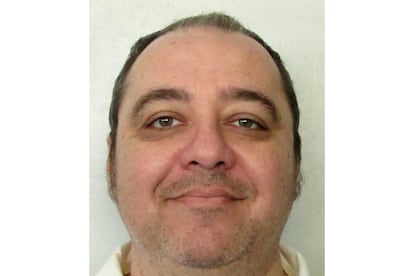Alabama to test new nitrogen gas execution method on inmate it already tried to kill
Death row convict Kenneth Eugene Smith, who is scheduled to die on Thursday, survived the first attempt in 2022, when the executioner was unable to raise the vein to administer a lethal injection


The state of Alabama on Thursday plans to execute Kenneth Eugene Smith, convicted of the murder of a woman in the late 1980s, using nitrogen gas. It is not the first time they have tried: the state attempted to execute him in November 2022 by lethal injection, but eventually gave up when the clock was near midnight and the death warrant was about to expire. It was not an act of mercy, they simply couldn’t raise the vein.
Smith’s second date with death is also surrounded by uncertainty. The Alabama executioners will try a new method on him: gas asphyxiation. The plan involves placing an airtight mask on his face and forcing him to inhale pure nitrogen until he is deprived of oxygen, loses consciousness and dies. If it works, it would be the first innovation in the range of execution methods used in the 27 states where capital punishment has been legal since Texas introduced the lethal injection in 1982, a method that has been used to kill 1,377 convicts in 42 years.

Oklahoma and Mississippi also approved nitrogen hypoxia (its technical name) in 2018, but have not yet taken the step of using it. So there are no precedents for what may happen to Smith on Thursday starting at 6:00 p.m., other than what medical journals say about assisted suicides in Europe or workplace accidents caused by gas leaks. A federal judge last week rejected an appeal for clemency filed by the death row convict’s lawyers, and the Supreme Court decided this Wednesday not to intervene to stop the execution.
According to the procedure approved by Alabama authorities last summer, Smith will listen to his sentence as it is read out by the prison warden, he will be able to exercise his right to say his last words or to remain silent, and from the next room the system will be activated. The method differs from a gas chamber, still in force, although out of use in some states. The last prisoner executed this way was Walter LaGrand. It happened in 1999 in Arizona, and it took 18 minutes for the man to die inside a sealed room that was filled with cyanide.
The search for alternatives to lethal injection has intensified in recent years, given that pharmaceutical companies have been refusing, for reasons of corporate image, to sell these drugs to the states, whose stocks have expired. Additionally, in 2011, the European Union banned the export of these drugs to the United States. According to experts, this is the method that fails the most: NPR reviewed the autopsies of 200 inmates executed in this way and concluded that, despite the appearance that they died peacefully, 84% suffered pulmonary edema, a waterlogging that creates a sensation similar to drowning. The governor of Alabama, Republican Kay Ivey, imposed a moratorium, lifted in 2023, on its use after the failed attempt to kill Smith: it was the third time in a row that they had to return a prisoner to his cell after putting him through that macabre procedure.
Problems with lethal injection have caused execution by firing squad to return in some territories: Mississippi, Oklahoma, South Carolina and Utah currently consider it among their capital punishment options. Idaho and Tennessee are thinking about it.
United Nations complaint
The idea for execution with nitrogen gas came from Stuart A. Creque, a television horror and science fiction scriptwriter, who wrote an article in 1995 in the conservative magazine National Review in which he raised the possibility. Last September he defended it in another text, published in The Wall Street Journal and titled At last there is a humane method of execution. Activists against the death penalty and doctors have serious reservations about this, and have criticized Alabama’s new execution technique for everything that could go wrong: inhaling nitrogen could cause the prisoner to vomit and effectively drown. The gas might not do its job and leave Smith in a vegetative state. A nitrogen leak could occur.
Ravina Shamdasani, the spokesperson for the U.N. High Commissioner for Human Rights, protested last week against the announced execution, considering that “such an execution by gas asphyxiation in his case risks particular pain and suffering.” “We have serious concerns that Smith’s execution in these circumstances could breach the prohibition on torture or other cruel, inhuman, or degrading treatment or punishment, as well as his right to effective remedies,” said Shamdasani.
Smith, 58, was convicted of participating in the 1989 murder-for-hire of Elizabeth Sennett with another man named John Forrest Parker. They stabbed her and beat her to death with a fireplace poker in exchange for a $1,000 payment promised to each of them by the victim’s husband, an adulterous preacher who later called the police and tried to pass off the plot as a violent raid on the family home. When he found himself cornered, he committed suicide. Alabama killed Parker with a lethal injection in June 2010. A third person involved in the murder, Billy Gray Williams, was sentenced to life in prison without the possibility of parole and died behind bars in 2020. The victim’s two children are scheduled to attend Smith’s execution on Thursday.
In a written interview given to the BBC last week, the prisoner asked the state for clemency “before it is too late.” He said that “I’m nauseous all the time. Panic attacks hit regularly... This is just a small part of what I’ve been dealing with daily. Torture, basically.”
Another risk that experts warn about is that the airtight seal of the mask might fail or come loose from Smith’s seizures. A nitrogen leak could then end the life of the Reverend Jeff Hood, who will accompany the condemned man in his last moments. Hood has had to sign a document releasing the state of Alabama from liability if something goes wrong and he dies or ends up in a vegetative state.
Since 1976, the year the Supreme Court reinstated the death penalty in the United States, Alabama has killed 72 people. The first execution was in 1983. Currently, the inmate population on death row is 167 prisoners, five of whom are women.
Sign up for our weekly newsletter to get more English-language news coverage from EL PAÍS USA Edition.
Tu suscripción se está usando en otro dispositivo
¿Quieres añadir otro usuario a tu suscripción?
Si continúas leyendo en este dispositivo, no se podrá leer en el otro.
FlechaTu suscripción se está usando en otro dispositivo y solo puedes acceder a EL PAÍS desde un dispositivo a la vez.
Si quieres compartir tu cuenta, cambia tu suscripción a la modalidad Premium, así podrás añadir otro usuario. Cada uno accederá con su propia cuenta de email, lo que os permitirá personalizar vuestra experiencia en EL PAÍS.
¿Tienes una suscripción de empresa? Accede aquí para contratar más cuentas.
En el caso de no saber quién está usando tu cuenta, te recomendamos cambiar tu contraseña aquí.
Si decides continuar compartiendo tu cuenta, este mensaje se mostrará en tu dispositivo y en el de la otra persona que está usando tu cuenta de forma indefinida, afectando a tu experiencia de lectura. Puedes consultar aquí los términos y condiciones de la suscripción digital.
More information
Archived In
Últimas noticias
Families demand repatriation of bodies of Colombians who died in Ukraine: ‘This war is a slaughterhouse for foreigners’
James Cameron: ‘For the films I like to make to continue to exist, we have to find a way to make them cheaper’
Helen Levitt, the photographer who captured the theater of the everyday
The guardians of the meteorites of the Argentine Chaco
Most viewed
- Christian Louboutin: ‘Young people don’t want to be like their parents. And if their parents wear sneakers, they’re going to look for something else’
- US sanctions against jailed cartel leader ‘El Marro’ highlight Mexico’s lack of control over its prisons
- Cartels in Mexico take a leap forward with narco-drones: ‘It is criminal groups that are leading the innovation race’
- Liset Menéndez de la Prida, neuroscientist: ‘It’s not normal to constantly seek pleasure; it’s important to be bored, to be calm’
- ‘El Limones’ and the growing union disguise of Mexican organized crime










































